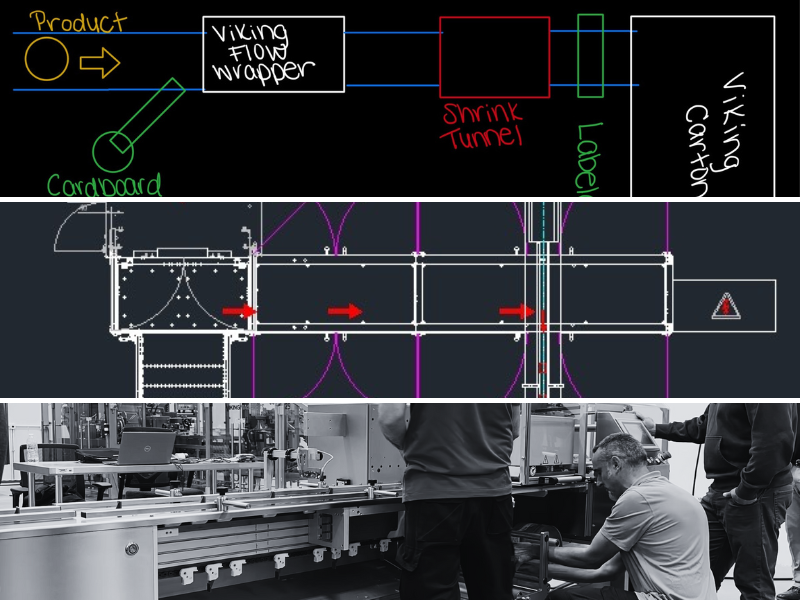[VIDEO] VFFS machine maintenance: How to set up the slitter blades on a stick pack machine
By Nate Farvour on October 21, 2021
![<span id="hs_cos_wrapper_name" class="hs_cos_wrapper hs_cos_wrapper_meta_field hs_cos_wrapper_type_text" style="" data-hs-cos-general-type="meta_field" data-hs-cos-type="text" >[VIDEO] VFFS machine maintenance: How to set up the slitter blades on a stick pack machine</span>](https://vikingmasek.com/hubfs/Imported_Blog_Media/Viking_Masek_YouTube_Thumbnail_quick_tip_slitter_blades_stick_pack.png)
What are slitter blades and what do they do?
The slitter blades on a multi-lane stick pack machine are a series of rotating knives that cut a flat sheet of packaging film into strips for the individual stick lanes of the machine.
The number of strips equals the number of packaging lanes on the stick pack machine. After the film is divided into strips, these strips are pulled through the machine, formed into individual stick packs, filled with product, and sealed shut.
Viking's stick pack machines come in a multitude of sizes and configurations to meet our customer's packaging needs. From the smaller, introductory ST400 to the colossal ST1200, the slitting assemblies for our stick pack machines all share common components, and the core functionality of the slitter assembly remains the same on all our stick machines.
Safety warning
Before performing a repair, be sure to follow your organization's Standard Operating Procedures (SOP) for safety, lockout / tag-out, and Personal Protection Equipment PPE guidelines. Do not perform work in the machine compartment of an energized and initialized machine. Do not bypass any safety switches or relays. Failure to use caution while working on the machine by not using adequate safety procedures could result in injury or death. Only authorized personnel should perform machine repairs. Viking Masek cannot foresee every instance where possible machine damage or an injury could occur. Work on the machine at your own risk. If you need assistance, schedule a service visit by one of our authorized technicians.
How to set up slitter blades on a stick pack machine
STEP 1. First, we need to figure out how wide we need to cut the film strips because this determines how far apart we place the slitter blades.
Let's do some math together to determine how wide our film strips need to be for our stick width. Film strip width equals our stick width in mm multiplied by two and then adding 10 additional mm for the seal area. The 10mm at the end is the width for the standard 5mm fin seal multiplied by two for both sides of the seal.
Film strip width = (Stick width (mm) x 2) + 10mm
For example, if we have a 23mm former to make 23 mm sticks, 23mm x2 is 46mm plus 10mm for the seal area makes 56mm. Our film strips need to be 56mm wide to make a 23 mm wide stick.
56mm = (23mm x 2) + 10mm
Cool thing, if you take it one step further and multiply the film strip width by the number of stick lanes on the machine, that gives us the needed width of the film roll. For example, if we run a 10 lane machine: 56mm x 10 equals 560mm, we need a 560mm film roll to run 10 lanes of 23mm sticks.
Web (film roll) width = Film strip width x number of lanes
A way to double-check our needed measurement is to measure the distance between the stick former lanes by picking a spot on one stick lane and measuring it to the identical spot on the lane next to it. This distance must be the same as the film strip width. One sure path to insanity is to slit your film considerably narrower than the distance between lanes and then attempt to make good stick.
Write down and hang on to the strip width measurement; we'll use that in a little bit for step 3.
STEP 2. Measure to find the center point between the middle two forming lanes. This point is where to place the middle slitter on the mounting rail in the slitter assembly.
On most machines, the center point between the middle two forming lanes is the center of the machine without the electrical cabinet attached. It is also the center of the hopper if you have the integrated Viking Masek auger filler, the center of the slitter assembly, and the center point of the middle two formers. Find the best way to measure and find the center point for your machine type and configuration.
Mark this center point on the slitter assembly's mounting rail with a pen or marker. Check to ensure its accuracy; the placement of all other slitter blades will rely on this mark.
STEP 3. Using the center point mark as a reference, place additional marks on the rail gapped at the distance found in step one. These marks will be where we place the rest of the slitter blades.
Do this on both the left and right sides. Make additional marks the same distance from the mark before it for the number of blades you have on your slitter assembly. All marks should be gapped the same distance apart in both directions from the center point for all the slitter blades on your machine. If everything is measured correctly, this should place a mark directly in between each stick lane.
STEP 4. With the slitter blades disengaged from the anvil roller, adjust the placement of the slitter blade by loosening the two 5mm socket head bolts at the bottom of the blade assembly that clamps the assembly to its mounting rail. Slide the assembly to the needed position, then tighten the bolts to lock it in place. Be sure to line up the marks with the blade tip, because the tip is where the film slitting magic happens.
STEP 5. Re-engage the blades and check your work by slitting some film. Adjust as needed.
Follow a comprehensive preventive maintenance plan
Machine preventive maintenance is one of the most important things you can do to ensure a long, productive life for your packaging line. Download our comprehensive VFFS machine preventive maintenance planner for daily, weekly, monthly, and yearly recommended maintenance tasks:

Related Posts

Optimizing packaging efficiency: The role of Flow Wrapping Machines in integrated systems

How to calculate the ROI on a potential packaging machine purchase
